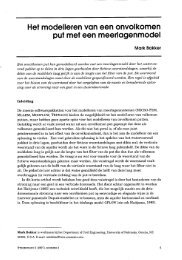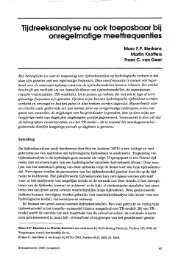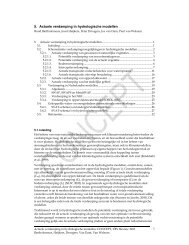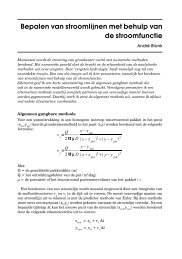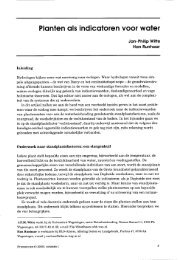Hydro-ecological relations in the Delta Waters
Hydro-ecological relations in the Delta Waters
Hydro-ecological relations in the Delta Waters
You also want an ePaper? Increase the reach of your titles
YUMPU automatically turns print PDFs into web optimized ePapers that Google loves.
marsh development <strong>in</strong> <strong>the</strong> east of <strong>the</strong> Western Scheldt.<br />
Just as <strong>in</strong> <strong>the</strong> case of morphologi~al developments, natural<br />
developxcents often take place on a time scale which far exceeds ehe<br />
term of <strong>the</strong> average government. This is particularly important <strong>in</strong> <strong>the</strong><br />
case of natural developments, because O~WOIIS of <strong>the</strong> desired course<br />
of such developments are subject to change. Bowever, this concerns not<br />
sa ioch <strong>the</strong> ecelogical conditions, which have been dealt with earlier,<br />
hnt ware <strong>the</strong> management and policy choices which affeet natural<br />
developaent. This applies particularly to former <strong>in</strong>tertidal areas.<br />
To date natural devel6pmenta <strong>in</strong> rhe <strong>Delta</strong> have sometimes faced us with<br />
unexpected situations. Although naru mre is knm of <strong>the</strong> directions <strong>in</strong><br />
which nacure can develop, it is important to be aware that <strong>the</strong> future<br />
may still hold surprises <strong>in</strong> this respect. S<strong>in</strong>ce hug-term developments<br />
are <strong>in</strong>volved, it is important to guard aga<strong>in</strong>st phas<strong>in</strong>g <strong>the</strong> successive<br />
stages too rigidly and aga<strong>in</strong>st try<strong>in</strong>g to steer <strong>the</strong>m too qnicklr <strong>in</strong> a<br />
certa<strong>in</strong> direction.<br />
Water meaagemeqt rewbs a key confro1 element iu natural development,<br />
especially tn areas along <strong>the</strong> banks. It is clveial to ma<strong>in</strong>ta<strong>in</strong> not<br />
only <strong>the</strong> quihity, but particularly <strong>the</strong> level of <strong>the</strong> vatar. nspits<br />
this fact, <strong>in</strong> almost no <strong>Delta</strong> area wat~rlavelmanageaeut is geared to<br />
natural development. This is due KO orher secid <strong>in</strong>terests hav<strong>in</strong>g been<br />
taken WO considmation. In <strong>the</strong> damstream freshwater areas of <strong>the</strong><br />
<strong>Delta</strong>, <strong>the</strong> potential for natural develapment would be optimally<br />
fur<strong>the</strong>red by waterlevel mmagement, which reflected <strong>the</strong> nacural rise<br />
and fall of waterlevels <strong>in</strong> downstream areas. In <strong>the</strong> case of <strong>the</strong> salt<br />
lakes of <strong>the</strong> Dslta this is leas clear-out. The best approach is<br />
probably to ma<strong>in</strong>ta<strong>in</strong> a standard level, with brief periods of flood<strong>in</strong>g<br />
<strong>in</strong> w<strong>in</strong>ter. Howeven, <strong>in</strong> <strong>the</strong> event of a review of or change <strong>in</strong><br />
waterlevel-ent great weight shanld 4e attached so <strong>the</strong> qatural<br />
development factor.





